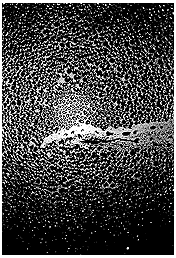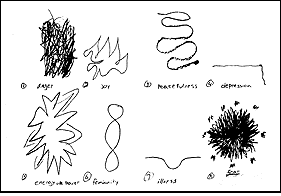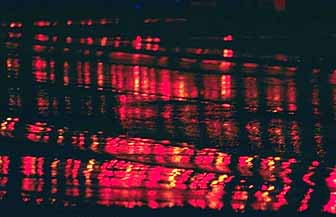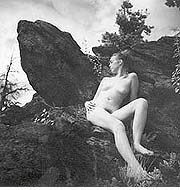Much research has been done since the time of this article and the study of the brain has indeed come a long way.
Findings: Depending on the stage of the creative process, and what you’re actually attempting to create, different brain regions are recruited to handle any particular task. One can choose on what to focus and this is called Selective Attention: Bottom Up Process – attention is given to details and they are pieced together into a bigger picture.
Top Down Process: driven by previous knowledge – attention is given to the bigger picture and tells one information/details for which to look. It is indeed fascinating reading.
But even with the new findings, the exercises within this article can help to develop and improve your photography.
Although many feel photography is a predominately left-brain exercise the truly successful photographer must be in touch with both his left and right brain modes of thinking.

In a previous issue we discussed positive and negative space, in part based upon the theories put forth by Barbara Edwards in her book, Drawing on the Right Side of the Brain.
When discussing the notion of left versus right brain cognitive modes we are not talking specifically of the exact location within the brain where these modes originate; this is subject to some intense debate.
We are talking about a general notion that is supported by a considerable amount of scientific research, regardless of the debate. Briefly, the right brain cognitive mode is characterized by emotional, non-linear, impulsive, intuitive forms of thought processes, while the left brain is said to be the source of the analytical, categorizing, linear, logical modes of thought.
As humans, we must rely upon both of these modes for survival, although many of us use one of these predominately over the other, based upon our character and our experiences in dealing with day to day problems and their solutions.
Many artists have traditionally considered photography a left brain endeavor, arguing that its technical nature necessitates an expertise that emphasizes that mode of thinking. I feel that this misperception has fueled the historical debate about whether photography is really “art.”
Even though, in the heyday of the debate, before anyone was using the terms left brain, right brain, many artists recognized a fundamental difference between the planned out, pre-visualized, analytical, technical approach of photographers of their day, and the emotional, intuitive, impressionistic, almost spiritual endeavor with which the “real” artist was involved.
Curiously, it was the camera itself which may have been responsible for the shift of many artists towards a more right brain approach and away from styles that stressed technique, pre-visualization and planning that had been important in the rendering of subjects realistically, because the camera, with its speed and cheaper cost made such art redundant, to use today’s terminology.
The heat up of the controversy tended to polarize each camp into a way of thinking that has been detrimental to both camps, especially photographers.
How many times have I heard in a class or exhibition, a photographer when coming upon a photograph that is more abstract than representational remark, “This artsy-fartsy stuff just isn’t for me.” Unfortunately this remark has more often indicated a lack of understanding of what his colleague was trying to convey to him, rather than a true preference.
In truth, an artist, photographer or otherwise, needs to be integrated in his or her approach to photography. Most successful photographers, whether predominately left or right brained, nonetheless rely on the opposite cognitive mode for their success.
This can readily be understood simply by talking to the photographers about their work. The left brain oriented photographer whose equipment and skill in lighting and/or printing are paramount to his work, will nonetheless talk about not knowing why he hit the shutter when he did on a particular photograph, or talk about a particular photograph having special emotional meaning to him, although he can’t really explain why.
This is the right brain influencing his photography.
On the other hand, more right brained photographers using cameras from cereal boxes or discovered in the dusty recesses of an ancient attic will tell you they think about what they are shooting and whether their particular piece of equipment will capture and record it And that they have learned that certain subjects and lighting just don’t result in the look and feel of the photographs they seek to produce.
But, alas, I think that there are more left brained oriented photographers than not, and many will argue that is because we are predominately men, and by nature we tend to be left brained in our thinking.
I see this tendency in many of my students who are altogether too fervent in their pursuit of the mastery of technique, believing that with the right camera, film and technical know-how they will have all they need to be the next famous photographer.
It is very difficult to teach someone to be more right brained. In fact the stuff this cognitive mode is made of is the antithesis of the analysis and examination that must go into trying “to teach.” So often, rather than trying to explain it, it must be shown.
One exercise that I use involves drawing. Feel free to try this at home. It must be done with a group, or you’ll miss the impact of it. Five people are the minimum, and it also helps to make sure the group is gender mixed. If you have the chance to include as a member of the group someone from a foreign country, so much the better.
Give each person a 8 ½ X 11 sheet of paper, and pencil or pen. Have each person fold the paper in half and then in half again, and then once more. When opened, the paper should have eight boxes formed by the folds. Have each person write the following words, one in each box, as small as they can in the corner of each box:
tranquility (or peace), anger, femininity, masculinity, joy, loneliness, depression, energy.

Although your subjects may be different, your results should look something like this.

Make your pictures abstract – the equivalent of a scribble.

When you’ve done this exercise described in this article, you’ll know why this picture is entitled “Masculinity”.
Take no more that 5 minutes to complete this entire exercise. Have each person draw within the boxes, in broad non-representational strokes what their hands wants to draw when they close their eyes and imagine the feelings that accompany each word.
These should be quick broad strokes, without thought about trying to “draw something.” You don’t want smiley faces for happiness, for example, all you want are a scribbles. Also be sure to tell everyone that there should be no peeking.
This is a test, no sharing please. When everyone is done, lay the papers out on a flat surface and look at what your efforts have wrought. It will be amazing, it will be fantastic. Almost everyone will have drawn the same thing or very nearly so.
In fact no matter where in the world you conduct this test, the results will be similar to your group’s. It’s what the universality of art is about. We all recognize and express emotions in much the same way. This is not only true of art but music as well. These emotional elements have distinct rhythmic components, recognizable in any culture.
If you go to an art museum now, you’re going to be surprised because you’re going to see art in a whole new light. You’re going to see elements of your “test” in many works of art. And lo and behold some of that “artsy-fartsy” stuff is going to make sense.
But what does this have to do with photography. Well, just like the painters, you can use these elements in your photography to express the same emotions. If your test group were photographers, have them pick one of the emotions they drew and try to shoot a 36 images to try and represent it.
Print them and bring the prints back to the group and share the photos with them. Can the others guess what the shots are about? In most cases it will be easy. Make sure no one chooses tranquility; it’s too easy!
After you see the results of your test you’ll see why, and you’ll have a new understanding of your photography. Also stay away from the strictly representational. For joy, don’t shoot people laughing, or for femininity avoid things like lingerie or other articles identifiable with women. Instead look for the abstract. Look for the equivalent of a scribble.
Some photographers will find this exercise difficult, others will find it immensely enjoyable. I have often heard the following remark from students. “I was driving downtown last night, and I saw________ everywhere!”
Most often people see masculinity or anger in the shapes and sights of the city, but you’ll be surprised how many people also see joy. These people are seeing through the filter of their right brains, the object of the exercise.
Other subjects for your photography which will help develop your right side are those generally associated with elements of composition. Confine yourself to shooting multiple images of a single subject such as “light,” “texture,” or “line.” Just one of these.
Later combine two of them. In other words the subject of all of these photos will be just the one or two words. This exercise will open you up to a whole new way of seeing, making you sensitive to things around you that you have taken for granted. And like the emotion exercise you’ll start seeing the object of your photographs everywhere.
Other subjects are harder but rewarding, and they begin to integrate the left side into their execution.
Try shooting photographs about your dreams. Write down as much as you can about a dream you have the night before. Can you shoot a photograph that captures the spirit of it in some way?
Try all of the exercises and you’ll begin to look at your photos and the photos of others in a whole new light.
by Michael Fulks

Leave a Reply